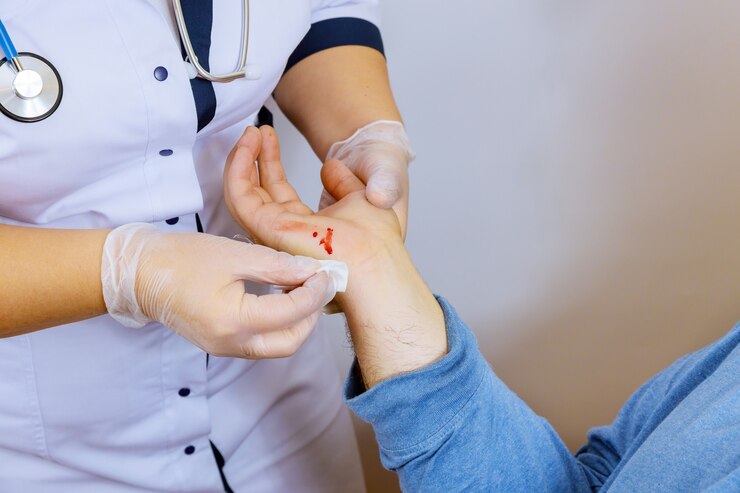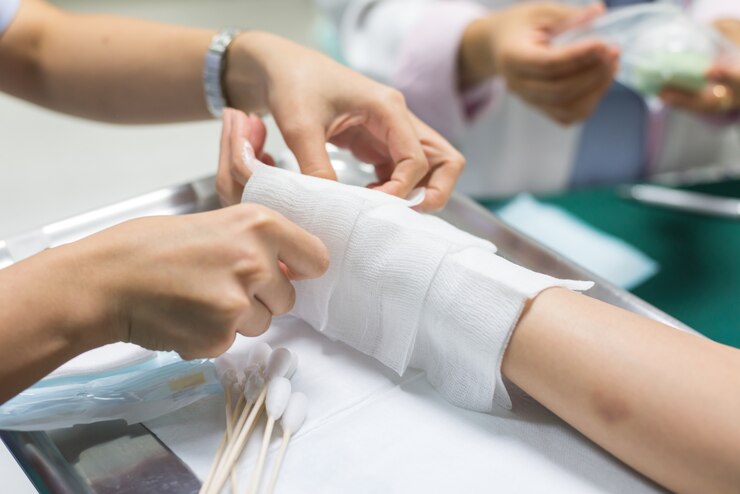What is Wound Care?
What is Wound Care?
A wound is a break in the skin caused by an injury (such as a cut or blow), surgery, or conditions like diabetes. Wound care refers to the treatment and management of a wound until it heals, addressing both immediate medical needs and future precautions.
What is a Dressing?
A dressing is a sterile pad or gauze (compress) applied over a wound. The type of dressing used may vary depending on factors such as the nature of the injury, its size, location, and severity.

Types of Dressings
This type of dressing is used for burns, wounds that emit liquid or are necrotic, and pressure or venous ulcers.
This dressing is used for dry, painful, necrotic, or infected wounds, second-degree burns, and pressure ulcers.
This dressing is used for wet wounds with high liquid drainage, burns, packing wounds, and venous or higher-stage pressure ulcers.
This dressing is used for chronic, stalled, or surgical wounds, transplant sites, ulcers, burns, pressure sores, or large injuries.
This dressing is used for wounds of varying degrees and severity, including those that emit odors.
This dressing is typically used by medical professionals or caregivers.
This is the most commonly used dressing for all types of open wounds or broken skin. It is suitable for minor injuries such as grazes, cuts, and similar wounds.
Purposes of Wound Care and Dressings
The main objectives of wound care and dressings are to:
- Help reduce pain and prevent infection
- Decrease purulent wound drainage
- Provide a clean and dry environment for healing
- Immobilize, protect and support the wound
- Ensure healing as fast and effective as possible
- Apply medication to the wound
Schedule an Appointment Today
If you or a loved one may benefit from treatment, book an appointment with us today!

Steps involved with Wound Care and Dressings
Typically, wound care and dressings involve:
- Bleeding control
- Wound cleansing
- Actual dressing of wound
This is the first and most important step. Bleeding can be stopped by applying pressure with your hands or with gauze, if available. Alternatively, you can allow the blood to clot (coagulate) naturally
Once bleeding is controlled, cleanse the wound with mild soap or liquid soap and warm water. The wound should be rinsed thoroughly, ensuring water reaches the entire depth of the wound. After cleaning, gently pat the wound dry with a clean, soft towel.
Thoroughly wash and dry your hands. If available, wear disposable gloves. Use a dressing that is slightly larger than the wound to ensure full coverage. Hold the dressing at the edges and apply it, making sure to keep your fingers away from the part of the dressing that will cover the wound.
Dos and Don’ts of Dressing Wounds
Dos
- Always clean the wound before applying a dressing.
- Seek medical advice on cleaning and dressing the wound.
- Change the dressing every 12 hours.
- Stop the bleeding first before dressing the wound.
Don't
- Leave the wound open if cleaning is not possible.
- Do not dress a wound with visible infection.
Important Links
Practice Location
- © Dr. Neil Desai, Vascular Surgeon Cypress, Houston, TX

